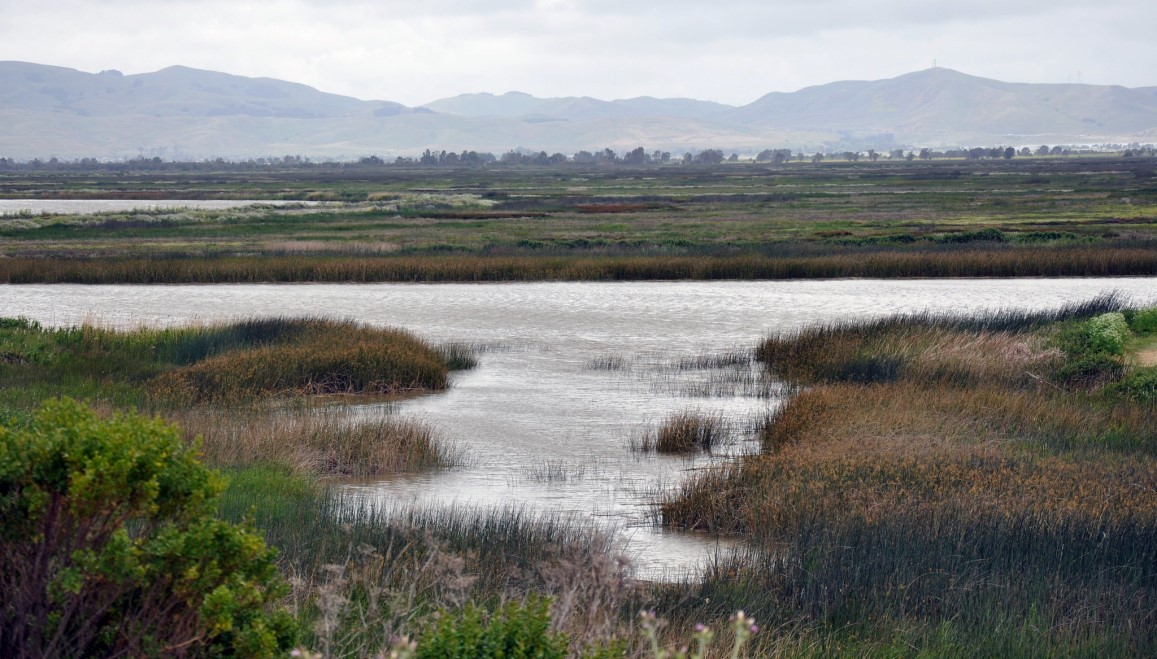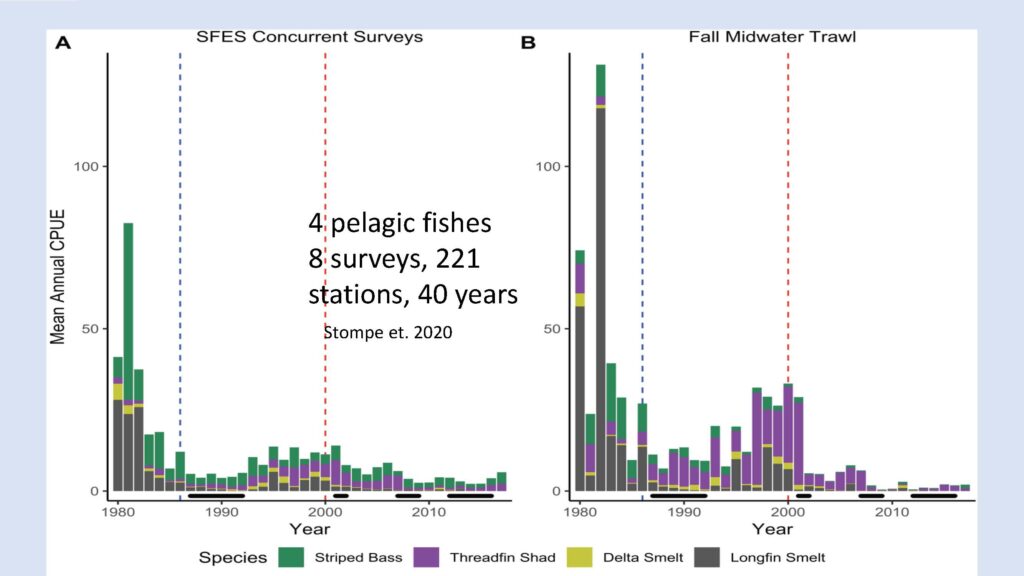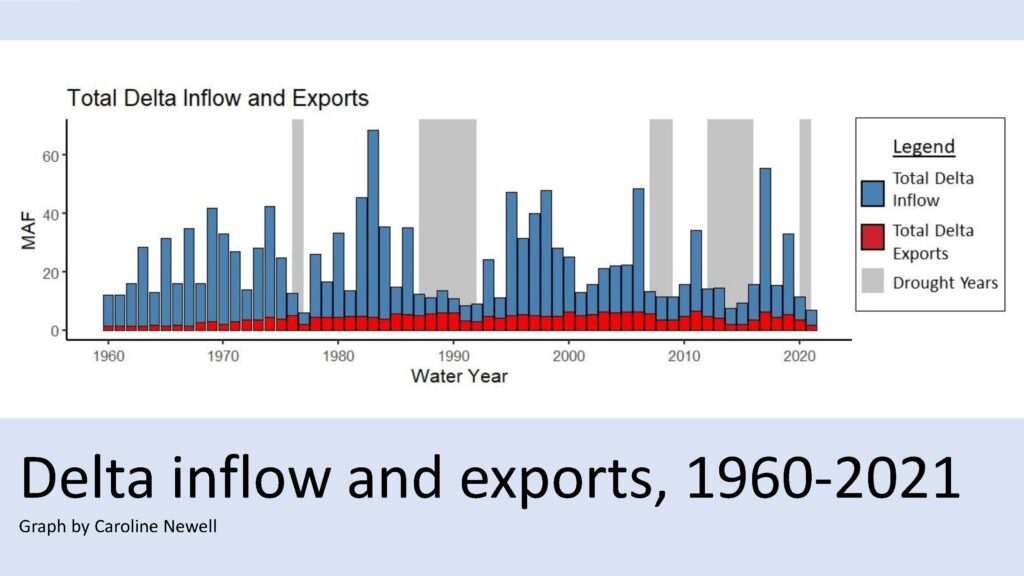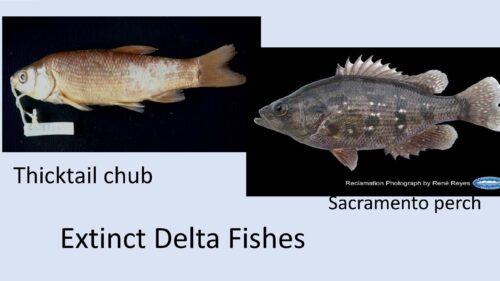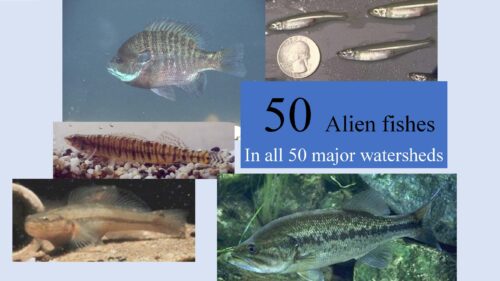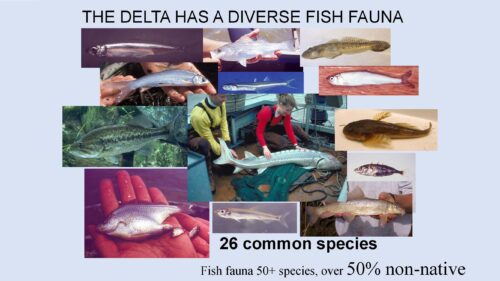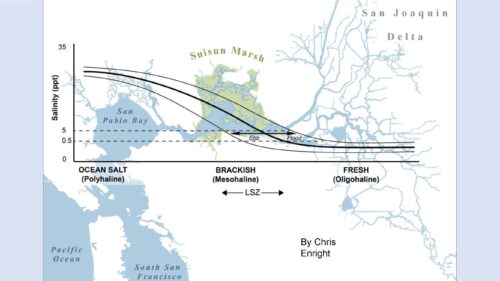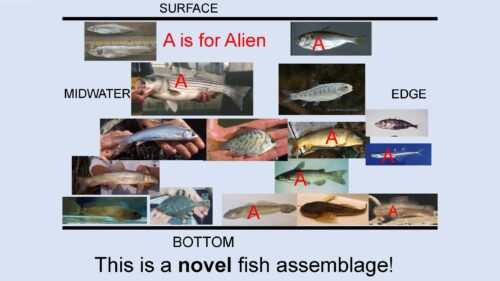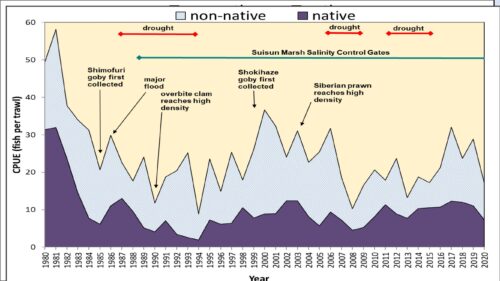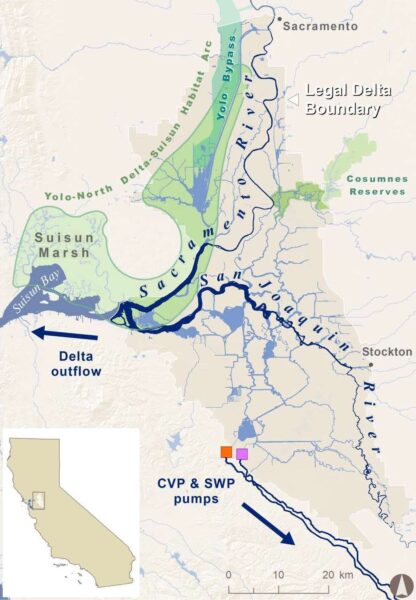 Dr. Peter Moyle is a distinguished professor emeritus and Associate Director of the Center for Watershed Sciences at UC Davis. He has studied the ecology and conservation of fishes in freshwater and estuarine habitats in California for over 50 years.
Dr. Peter Moyle is a distinguished professor emeritus and Associate Director of the Center for Watershed Sciences at UC Davis. He has studied the ecology and conservation of fishes in freshwater and estuarine habitats in California for over 50 years.
At the February meeting of the Delta Independent Science Board, Dr. Moyle provided an overview of Delta fish, explaining why some fishes have become overabundant and others are headed for extinction, all while being participants in a novel ecosystem.
The map shows the location of the North Delta Arc in green, which encompasses the area from Suisun Marsh to the Yolo Bypass. This is the area where Dr. Moyle has been focusing his efforts.
“The rest of the Delta is very different,” he said. “It is much more dominated by non-native species than is the North Delta Arc.”
Dr. Moyle pointed out that we know a lot about Delta fishes; there’s been systematic monitoring since 1957. Currently, there are 14 fish surveys with at least 18 years of sampling.
On the slide below, the graph on the right shows the Fall Midwater Trawl survey data, which surveys for important pelagic species. He noted that there are a lot of fluctuations, but the populations have been very low since the early 2000s.
Recently, research by Dylan Stompe, a Ph.D. candidate at UC Davis, combined the different surveys; the result is shown above on the left. The graph shows the combination of four pelagic fishes from eight surveys and 221 stations throughout the San Francisco Estuary over 40 years.
“This shows you the same thing as the Fall Midwater Trawl, but here it is a bit smoother because the different fishes respond in many different ways to environmental change,” said Dr. Moyle. “But the same thing is going on. You can see a major decline in the pelagic fishes in the 1980s, a slight recovery, and then back to really low numbers again. This is an ecosystem-wide problem for the entire estuary, not just the upper estuary.”
The graph below shows Delta inflows and exports; the blue bars show the total amount of water that flows into the Delta, the red bars are how much of that water is exported, and the gray bands are the droughts.
“What you notice is that in dry years, the amount of water exported could be a very significant percentage of the amount of water flowing in, which is a problem for the fish,” he said. “Inflows tend to decrease during the drought, but exports tend to remain pretty much the same, at least until very recent years. So this reflects something that’s borne out in the ecosystem and affects all these fishes.”
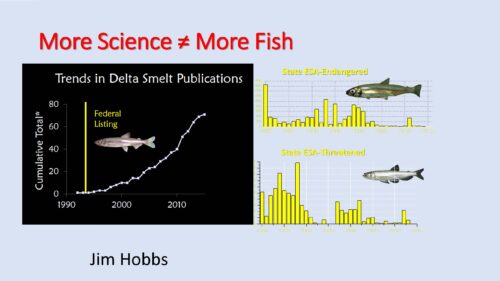 Because these fish are in the Delta – the middle of California’s water supply system – there has been a lot of money for research, but it hasn’t helped the species all that much.
Because these fish are in the Delta – the middle of California’s water supply system – there has been a lot of money for research, but it hasn’t helped the species all that much.
“The slide shows the number of publications, which keeps going up, but Delta smelt numbers keep going down,” said Dr. Moyle. “I’m not sure what that proves. But it shows that even if your science is great, you need to have management that uses the science to make a difference.”
The Delta smelt was listed in 1993, but it is not the only listed species in the system. The winter-run chinook salmon were listed in 1989. And the longfin smelt, green sturgeon, spring-run chinook salmon, and Central Valley steelhead are all also listed as endangered species. These species have to be managed as they go through the Delta, and when they are in the Delta, he noted that it makes a considerable difference in how the systems are managed for water supply.
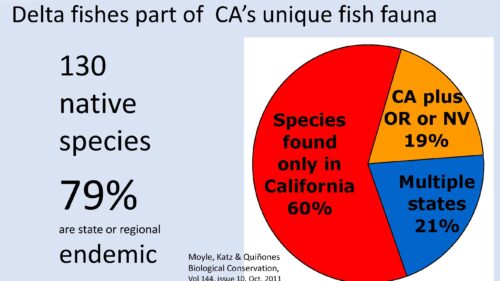 What goes on in the Delta reflects what’s going on in the rest of the state, Dr. Moyle said. “We have 130 native freshwater fish species. And roughly 80% of these fish are endemic to California, including watersheds that may go out of state for short distances. So our species, such as the Delta smelt and so forth, are California problems. There’s no equivalent elsewhere.”
What goes on in the Delta reflects what’s going on in the rest of the state, Dr. Moyle said. “We have 130 native freshwater fish species. And roughly 80% of these fish are endemic to California, including watersheds that may go out of state for short distances. So our species, such as the Delta smelt and so forth, are California problems. There’s no equivalent elsewhere.”
“We’ve already lost seven species from the system. We have 30 species listed under state and federal ESAs as threatened or endangered, and 63 species that are fish species of special concern in California,” he continued. “So statewide, you could argue that 71% of all the fish in California are in serious decline or trouble. So what goes on in the Delta is a reflection of what’s going on statewide. Each species has different problems in some respects, but they’re all related.”
Among the extinct native species is the thicktail chub, last detected in 1955. The Sacramento perch, once a very abundant species, is fortunately still around because it has been planted in ponds and reservoirs all over the West. Still, it’s gone in its native habitat, which is the Delta.
“These species were two of the most abundant species in the system prior to the arrival of Europeans,” said Dr. Moyle. “When you look at Indian remains, the remains of these fish are the most among the most abundant.”
Another challenge is the constant invasions of non-native species. “We have at least 50 alien or non-native species of fish present in every watershed in the state – not all 50 in any given watershed, but they are spread around. A lot of these fish are in the Bay-Delta system. This creates a lot of complications when you’re trying to manage the native fish. The San Francisco Estuary has been listed as the most invaded estuary in the world. With the invertebrates and everything else added together, it can be close to 200 species.”
The Delta has a very diverse fish fauna; fish surveys usually net about 26 to 30 common species; about half will be non-native fish.
What fish you capture is somewhat dependent on where you’re looking, he said. The Delta is artificially maintained as a freshwater system. If you track the salinity gradient, the middle reaches of Suisun Bay and the Suisun Marsh are brackish and are some of the most productive and species-rich areas in the Delta.
The community of fishes is a mixture of native and non-native species. “We’ve done some formal analysis on these,” Dr. Moyle said. “There are some species that overlap more than others, but by and large, studies of diet and habitat overlap and so forth show a lot of segregation among the species.”
The slide on the upper right shows data from Suisun Marsh for fish abundance from 1980 through 2020. The purple on the bottom are the native species; the light blue are the non-native species. The graph shows how the two general groups track one another in abundance, which generally means they respond to the estuary’s environmental conditions similarly.
Invasive species are also noted on the chart, such as the overbite clam, Shimofuri goby, Shokihaze goby, and Siberian prawns. “So we’re constantly dealing with new species coming in, as well as with natural changes such as drought,” he said. “And artificial changes in this case, as Suisun Marsh had salinity control gates constructed in the 1980s to keep the marsh fresher. So overall, you can conclude the Delta is very poor habitat for pelagic fishes, which are some of the more important fishes in the system.”
Fish stories
Then, Dr. Moyle gave five non-random fish stories intended to explain some of what is going on in the system.
Chinook salmon
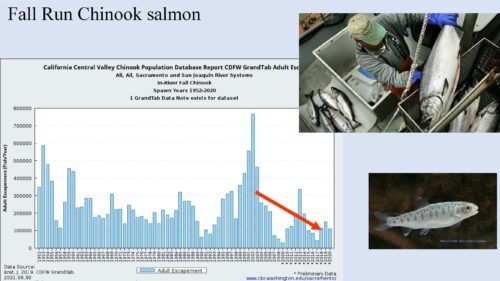 Fall-run chinook salmon is the dominant salmon run in the system; it is the run that supports the commercial and sport fisheries. As adults, the salmon move up into the rivers to spawn; the juveniles move down the rivers and go through the Delta to go out to sea to grow up.
Fall-run chinook salmon is the dominant salmon run in the system; it is the run that supports the commercial and sport fisheries. As adults, the salmon move up into the rivers to spawn; the juveniles move down the rivers and go through the Delta to go out to sea to grow up.
The small juveniles are very vulnerable to climate change or other environmental changes in the system, especially in the Delta. And they’re also vulnerable to predation and other factors. Because the juvenile mortality is so high, these fish are largely supported by hatcheries; they are a conservation-dependent species. Despite that, the Chinook salmon have been steadily declining in recent years.
The winter-run chinook salmon are doing the worst, Dr. Moyle said. Winter-run chinook are unique to California. They come up the rivers into the Sacramento Valley in the winter months and spawn in the spring. The rivers in the north valley are fed from cold-water springs, which keep their eggs cool as they incubate during the summer months.
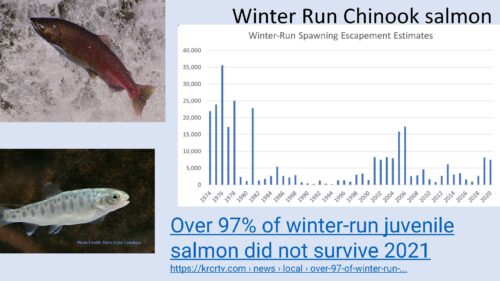 “These fish came in and took advantage of a habitat other salmon were not using because they were using it at a time of year when nobody else was around,” noted Dr. Moyle.
“These fish came in and took advantage of a habitat other salmon were not using because they were using it at a time of year when nobody else was around,” noted Dr. Moyle.
The construction of Shasta Dam cut off access to the McCloud River and others. The result was that the winter-run salmon became completely dependent on cold water releases from Shasta Dam. This requires maintaining a cold water pool in Shasta Reservoir to use during the summer to keep the winter-run juveniles alive.
“What’s happened now several times but specifically in 2021 was that almost all of the winter juveniles in the gravel died because the Bureau of Reclamation released water earlier in the year for farmers,” said Dr. Moyle. “They did not save enough of the cold water in the pool for the salmon, so they ran out of cold water, and the warm water killed the juveniles.”
“This makes the winter-run almost entirely a hatchery-dependent run again. It was pretty much that way anyway, but a small wild population was going. So after this event, we have to find other solutions to keep the winter-run chinook going. It’s a typical problem for California.”
Delta smelt
The Delta smelt is a fish Dr. Moyle has been working with since the 1970s when he became the expert on Delta smelt as an assistant professor because nobody else wanted to study it. At the time, it was one of the most abundant fishes in the system, so it was easy to get samples to do studies on.
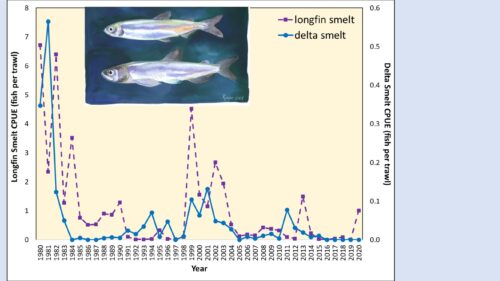 The graph shows the abundance of the Delta smelt and the longfin smelt. The Delta smelt abundance declined in the 1980s, made a brief resurgence, and then disappeared from the system.
The graph shows the abundance of the Delta smelt and the longfin smelt. The Delta smelt abundance declined in the 1980s, made a brief resurgence, and then disappeared from the system.
“The Delta smelt today is basically gone from the wild, but no one yet wants to declare it extinct in the wild,” said Dr. Moyle. “It is being maintained now by a hatchery, something I never thought they could do because it’s such a delicate species, but it’s been raised for its entire lifecycle through in hatcheries.”
“The Delta smelt have a one-year lifecycle, two, if you’re lucky. That means this species is very vulnerable to anything that goes on in one year; it is vulnerable to genetic disorders. It’s very vulnerable to anything that goes on in the system. And the fact they have such a short life cycle tells you that historically, the Delta always had a place for it somewhere. So this species could maintain its abundance despite a one or two-year life cycle.”
“Indeed, some of the otolith work done on some of the last remaining fish suggested they had multiple strategies for using the estuary. It’s just too bad it’s disappeared because it was a fascinating fish in so many ways.”
Mississippi silversides
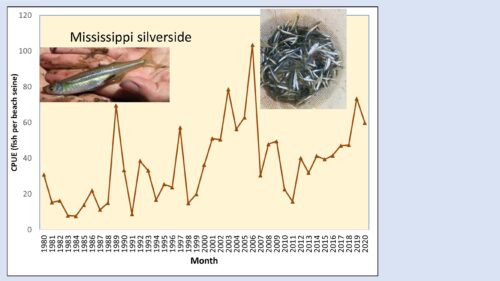 On the other hand, the Mississippi silverside is increasing in numbers. The fish were introduced into Clear Lake in 1969 and has since spread through the system, arriving in the Delta in the early 1970s. It is now one of the most abundant fish in the system and can occur in saltwater or freshwater.
On the other hand, the Mississippi silverside is increasing in numbers. The fish were introduced into Clear Lake in 1969 and has since spread through the system, arriving in the Delta in the early 1970s. It is now one of the most abundant fish in the system and can occur in saltwater or freshwater.
“Unfortunately, the place where it likes to hang out on the edge of the sloughs is also where the Delta smelt spawn, and we know from experiments that it’s a voracious predator on eggs and larvae of delta smelt and any other fish egg it gets hold of,” said Dr. Moyle. “Its numbers have gone up and down according to various factors, but the general trend has been up, and the numbers are still going up. It is one of the many factors affecting Delta smelt population”.
Striped bass
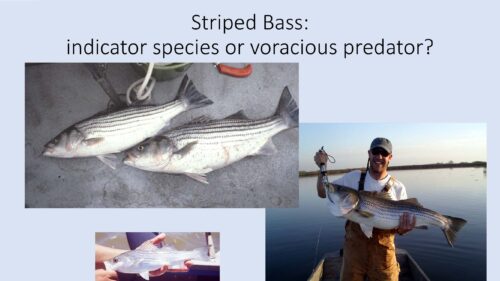 Striped bass were introduced into the system in the 1870s and quickly became abundant. It adapted well to the San Francisco Estuary, using the entire estuary and the rivers that flow into it for its life cycle. It goes up into the Sacramento River to spawn. The eggs wash downstream, and the larvae hatch in the low salinity zone, usually around Suisun Bay, where there was abundant food historically. They grow up and spend the rest of their life in the estuary with the juveniles and adults showing some segregation, although juvenile striped bass can also be an important food for the adult bass. Some of the bass go out to sea, but most do not.
Striped bass were introduced into the system in the 1870s and quickly became abundant. It adapted well to the San Francisco Estuary, using the entire estuary and the rivers that flow into it for its life cycle. It goes up into the Sacramento River to spawn. The eggs wash downstream, and the larvae hatch in the low salinity zone, usually around Suisun Bay, where there was abundant food historically. They grow up and spend the rest of their life in the estuary with the juveniles and adults showing some segregation, although juvenile striped bass can also be an important food for the adult bass. Some of the bass go out to sea, but most do not.
“Here is a fish which uses the entire estuary, but it’s a non-native species,” said Dr. Moyle. “So as a species, I increasingly think it is probably the best indicator species we have of Delta estuarine health. But other people look upon it as a voracious predator; it’s a non-native fish that feeds on salmon and other native fishes; therefore, it must be bad. I say just the opposite; there have always been predators out there, and the striped bass have simply replaced the native predators that were once present.”
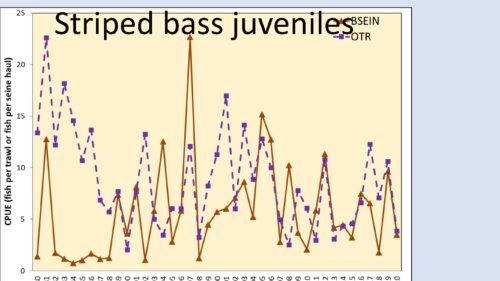 The slide shows the juvenile striped bass numbers in Susan Marsh. “The marsh is turning out to be a refuge for the pelagic fishes and native fishes in the system. That has been one of the surprising results of our studies. Numbers are declining and juvenile numbers are way down elsewhere. But in the marsh, they’re remaining fairly steady.”
The slide shows the juvenile striped bass numbers in Susan Marsh. “The marsh is turning out to be a refuge for the pelagic fishes and native fishes in the system. That has been one of the surprising results of our studies. Numbers are declining and juvenile numbers are way down elsewhere. But in the marsh, they’re remaining fairly steady.”
Sacramento splittail
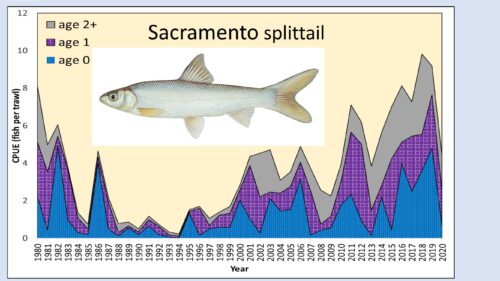 The abundance of the Sacramento splittail, a native species, is shown on the slide. The Suisun Marsh is its principal habitat. It was abundant in the 1980s but experienced an abrupt decline. It was briefly listed as a threatened species in the 1990s, but the population recovered partly because of the restoration of floodplains upstream on the Cosumnes River and in the Yolo Bypass, which provided habitat, giving the species what it needed to complete its lifecycle.
The abundance of the Sacramento splittail, a native species, is shown on the slide. The Suisun Marsh is its principal habitat. It was abundant in the 1980s but experienced an abrupt decline. It was briefly listed as a threatened species in the 1990s, but the population recovered partly because of the restoration of floodplains upstream on the Cosumnes River and in the Yolo Bypass, which provided habitat, giving the species what it needed to complete its lifecycle.
The fish rear in brackish water and feed on mysid shrimp and other species. When the high spring flows come, the fish move upstream and spawn on floodplains. The eggs hatch and grow on the floodplain for a month or so. Then, as the water drops in the floodplains, they leave the floodplains and are carried back downstream to Suisun Marsh and the lower reaches of the estuary.
“The numbers have been pretty good in recent years,” said Dr. Moyle. “Look at the blue; that shows you the abundance of young of the year. You can see that there are many years when their reproduction basically fails. But these fish live long enough, so they can maintain a population indefinitely as long as they have periodic success in spawning and the floodplain rearing. But, interestingly, this is a species that has rebounded a bit because of restoration projects in a different kind of habitat.”
Conclusions
Dr. Moyle then gave the conclusions. “We have a fish fauna that is surprisingly well documented. There is a lot we need to know about many of these fishes, but we actually do know a lot about them.”
“The assemblies of fish you find in any given place in the system vary somewhat, but there is a mixture of native and non-native species. However, the native species are disappearing. They’re doing their best in areas with close association with the Sacramento River, where clean, cold water is available, and the floodplains and other habitats that favor the native fishes.”
“The pelagic fishes, in general, are in decline, which is reflected especially in the Delta smelt, which is a species which, just despite an enormous amount of research going into its lifecycle and factors affecting its health, has disappeared from the wild and is now maintained entirely as a hatchery fish. And that, of course, reflects what’s also going on with Chinook salmon, the other important species in the system.”
In closing …
“I just want to remind you again that water is the issue here,” said Dr. Moyle. “For all these fish directly or indirectly, how we use water in the Delta and upstream reflects their ability to survive in the future years.”
“The basic problem we have in California is competition for water, and water is a scarce resource. You have two major competitors: the fish and people. And people are winning.”
QUESTIONS & ANSWERS
ROBERT NAIMAN: Of all the years you’ve been working in the Delta, what do you see as the one or two biggest issues? How could this board help resolve some of these issues or move the situation towards a more positive outcome? What role would you see for us?
Dr. Peter Moyle: “That’s such a difficult question because the problem with water being so important in California is that it’s a lever that the managers can push. You can have some control over the water coming into the Delta and some control over water and export. And we know it has some effect on fish populations. But it’s only one problem of many.”
“More recently, the problems have come from invasive species. We have the overbite clam, which has taken away most of the primary productivity from the system that used to be important for the pelagic fish; It literally coats the bottom and the brackish water parts of the estuary. And this changed it from pelagic productivity to benthic productivity. We have invasive aquatic weeds, such as Brazilian waterweed and water hyacinth, which choke up channels. It creates a habitat that favors non-native species like largemouth bass and bluegill; it definitely does not favor the natives. We have the Mississippi silverside, which has taken over the shallow water habitats – those are problems that are very hard to deal with. It’s hard to get rid of invasive species; once it’s in, all you can do is control them. So certainly, one of the things to be looking at is how you can control some of these species. Can you actually reduce the number of invasive clams, for example? I think there may be ways to do that.
“Perhaps another important thing is to emphasize the need to find ways to stop new invasions because new species are coming in all the time. There’s a lot of effort to reduce this, but they still managed to come in. And I don’t know what can be done, but more stringent controls and regulations.”
“But one thing certainly is to recognize each species for what they are. Recognize that we now have a system, which is a novel ecosystem; it’s not going to change, and trying to bring it back to some pristine state is just never going to happen. So be realistic about that. I think it’s a really important vision for the future, but recognize we still need to do what we can to keep the native fishes going.
“One of the things that I’m looking at especially is the idea of floodplains. Floodplains are good for salmon, splittail, and probably some other native fishes. So encouraging the protection and management of floodplains for fish is certainly a major issue.”
“Finally … the importance of Delta islands, recognizing that the Delta is going to be changing dramatically in the future as a result of sea level rise, and climate change, which is increasing the big floods and so forth. Many of those islands will become submerged; they are already somewhere about 20 feet or more below sea level. The levees will break and fill up with water, and some of that water could be saltwater. So there’s a need to look at those islands on a rational basis and try to figure out how you can manage the Delta of the future, but it’s going to change, and all these changes are predictable.”
“But there’s also a lot of people who want the status quo because they’re used to it. So try to disabuse people of that because things will change, and you need to find new and better ways of solving some of these problems.”
QUESTION: Dr. Laurel Larsen asked about predation … you alluded to predation when you talked about these different perceptions of striped bass and its role in the Delta. And my question is, how much of an issue or prioritization do these questions that the community has around predation deserve?
Dr. Peter Moyle: “There are some segments of people who work in the Delta and live there, especially the water purveyors – the tendency is to blame predation as the cause of declines of fish, as opposed to environmental conditions. It seems obvious; you have these big predatory fish out there, and when you look at their guts, they often feed on salmon … So, I think it’s important for people to recognize that predation is a natural factor. Striped bass are a predator species, but before striped bass, there were native predators out there. Plus, there are all kinds of birds and other animals that are predators of fish as well. So somehow, we have to get away from this idea that by controlling predators, you can solve all the Delta’s problems.”
“The way I look at it is predation is a natural problem. But it’s often associated with habitats that have been drastically altered. For example, largemouth bass, a non-native fish often accused of being a predator, has become abundant mainly because they’re associated with aquatic weeds, which has created a whole different habitat that was not there before. Yet, it’s very hard to demonstrate that they have any effect on Delta fish populations at all. Their diets are primarily crayfish; they feed on bluegill and other non-native fish. And yet there’s a tendency to want to blame them for the decline of fish.
“It’s getting back to the comment that is better looking look upon our system as a novel ecosystem that has all these components and natural systems that we’re going to continue to have and not try to look at manipulating one aspect or one part of the ecosystem to save native fishes or whatever your goal is.”
QUESTION: Dr. Steve Brandt noted that multiple issues could be driving the declines in fisheries, and invasive species are certainly a factor. There are a lot of things going on. What do you recommend going forward? What kind of tools would you need to manage this novel ecosystem down the road?
Dr. Peter Moyle: “It’s always good to toot the horn of Suisun Marsh as it’s where I’ve done much work, but it’s also a relatively small part of the total Bay-Delta system. And it has tidal gates so that you can regulate the salinity to an extent. In addition, most of the land is either wildlife refuges or duck hunting clubs. So it’s an area that, in the future, could be manipulated in ways to favor native fishes and species like striped bass.
“So it’s trying to find where are the areas you can do something with. The North Delta is another place. Unfortunately, it’s changing very rapidly now, just because aquatic weeds have invaded. But that was another place where we’re studying it and finding out there are all these backwaters sloughs that still have high productivity and were good places for rearing juvenile fish, and so forth. So I think the trick is to find out where the habitats are that you can manipulate to favor native fish and other desirable species … Where are those habitats? And what can you do to manipulate them in a way that keeps some of these non-native species at bay, or at least keeps them from being so dominant that they crowd out the species you want?
“It’s not easy because we’re talking about large-scale experiments. But we’ve already shown that on the Yolo bypass, floodplain manipulation by rice farmers and others is possible if you get everybody together, which has some very positive effects on salmon and steelhead populations. So it’s things like this that we have to be able to take advantage of and restore habitats wherever we can. But trying to manipulate and change the system on a large scale is very unlikely unless you can figure out some way to control numbers of species like the overbite clam. …
So we haven’t seen the ecosystem settle down, I guess to a point to an equilibrium that we’d like. So that really involves figuring out the ecosystem we want out there. What players do we want to be abundant? Which ones do we want not to be abundant? Then see if we can find ways to manipulate that.
“You don’t have to think about separating natives and non-natives because many of these species are compatible. American shad, for example, fit in well with the smelt. And striped bass are another good example of a species that actually fits in pretty well. So perhaps what we need to be thinking of is, what are the species that make a difference if we were to do something about it? The silversides are one; I don’t know what you do with it because it’s everywhere. Maybe you can harvest it. There are large-scale problems out there that are very hard to deal with.”
QUESTION: Dr. Harindra Fernando asked if there is a correlation between inflows and outflows and the decline in species.
Dr. Peter Moyle: “There’s nothing more studied in the system than outflow and inflow, but especially outflows because we’re always accusing the big pumps in the south Delta, which send water to the southern part of the state into the San Joaquin Valley, as well as the Bay Area cities – they’re always accusing that of being the main driver of the declines in fish populations. It is clearly a contributor. But because there’s so much else going on, such as invasive species … the diversions in the South Delta at the pumping plants are just part of the problem. Every river in California has a big dam that regulates flows in the rivers and all kinds of things that affect fish in the Delta … Salmon is the best example; their numbers are also tied to what happens upstream as well. What goes on in the Delta is a very difficult thing to deal with.”
QUESTION: Dr. Thomas Holzer asked about temperature. Should it be regulated?
Dr. Peter Moyle: “That’s the new big, big factor that people are finally considering in the models and so forth. The Delta smelt is a good example; it’s a cool water species, so when the temperature gets much above 22 to 23 degrees in physiological studies, they start having problems. … it was always assumed that temperatures were adequate in the estuary, partly because you get all these coastal effects that cool things down, but the Delta has become increasingly more lake-like with all the levees and so forth, which have made it more prone to higher temperatures.
“Many parts of the system are quite warm. I have thought that out-migrating juvenile salmon don’t make it through the Delta on the San Joaquin side, partly because the temperatures are just getting too warm. And that also makes them more vulnerable to predators. … So I agree with you that the temperature needs to be considered in models and any kind of planning in the system because the water will get warmer with climate change – unless we want to directly release more water from the big dams. And that’s not going to happen.”

